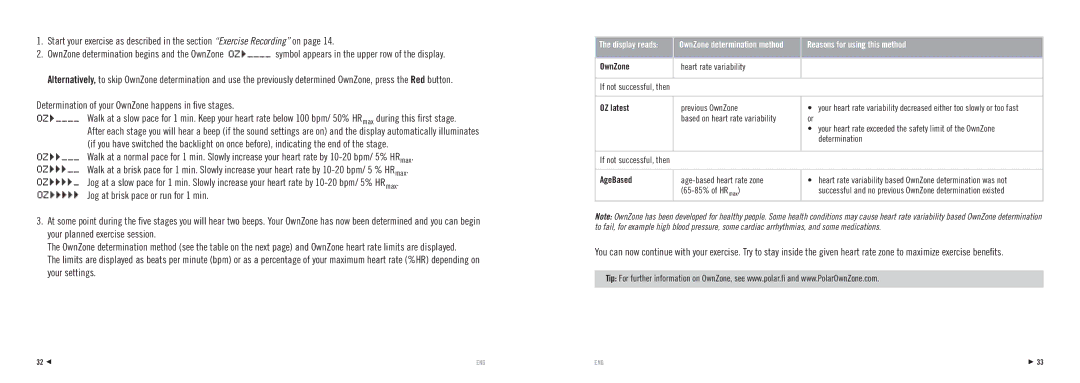
1. | Start your exercise as described in the section “Exercise Recording” on page 14. | |
2. | OwnZone determination begins and the OwnZone | symbol appears in the upper row of the display. |
Alternatively, to skip OwnZone determination and use the previously determined OwnZone, press the Red button.
Determination of your OwnZone happens in five stages.
Walk at a slow pace for 1 min. Keep your heart rate below 100 bpm/ 50% HRmax during this first stage.
After each stage you will hear a beep (if the sound settings are on) and the display automatically illuminates (if you have switched the backlight on once before), indicating the end of the stage.
Walk at a normal pace for 1 min. Slowly increase your heart rate by
3.At some point during the five stages you will hear two beeps. Your OwnZone has now been determined and you can begin your planned exercise session.
The OwnZone determination method (see the table on the next page) and OwnZone heart rate limits are displayed.
The limits are displayed as beats per minute (bpm) or as a percentage of your maximum heart rate (%HR) depending on your settings.
The display reads: | OwnZone determination method | Reasons for using this method |
|
|
|
OwnZone | heart rate variability |
|
|
|
|
If not successful, then |
|
|
|
|
|
OZ latest | previous OwnZone | • your heart rate variability decreased either too slowly or too fast |
| based on heart rate variability | or |
|
| • your heart rate exceeded the safety limit of the OwnZone |
|
| determination |
|
|
|
If not successful, then |
|
|
|
|
|
AgeBased | • heart rate variability based OwnZone determination was not | |
| successful and no previous OwnZone determination existed |
Note: OwnZone has been developed for healthy people. Some health conditions may cause heart rate variability based OwnZone determination to fail, for example high blood pressure, some cardiac arrhythmias, and some medications.
You can now continue with your exercise. Try to stay inside the given heart rate zone to maximize exercise benefits.
Tip: For further information on OwnZone, see www.polar.fi and www.PolarOwnZone.com.
32 | ENG | ENG | 33 |
